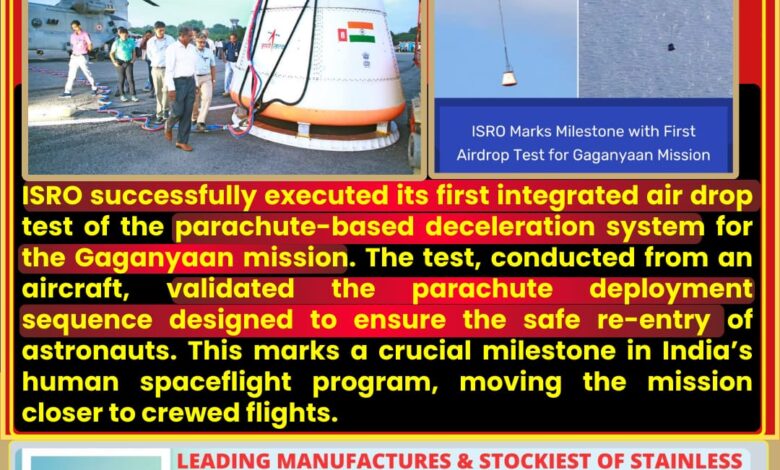
The Indian Space Research Organisation (ISRO) successfully carried out its first integrated air drop test of the parachute-based deceleration system. This crucial trial marks significant progress in India’s Gaganyaan mission, the country’s first human spaceflight program.
Test Overview
The test involved releasing the integrated parachute system from an aircraft at a predetermined altitude. Once released, the system deployed in a sequence of parachutes, designed to reduce the spacecraft’s descent speed to a safe level. Engineers monitored the deployment process, structural integrity, and performance consistency throughout the operation.
Role of the Parachute Deceleration System
The parachute-based deceleration system is critical for the crew module’s safe return to Earth after space missions. It ensures that astronauts experience controlled landing forces, protecting both crew and equipment. Successful functioning of this system is essential before India sends its first astronauts into orbit.
Gaganyaan Human Spaceflight Program
The Gaganyaan project aims to send Indian astronauts, known as Vyomnauts, into low-Earth orbit. With this test, ISRO has cleared one of the vital technological hurdles. The program, backed by ₹9,023 crore budget, is a flagship mission that will elevate India into the elite league of human spacefaring nations.
Technical Details of the Trial
The test evaluated multiple parachute canopies, deployment mechanisms, and timing systems. ISRO confirmed that the system functioned according to design, achieving stable descent rates and controlled behavior throughout. Data collected during the test will undergo detailed analysis before further trials are scheduled.
International Standards Compliance
The air drop test was designed in line with global human spaceflight safety standards. Comparable systems are used by NASA and Roscosmos. With this success, ISRO is on track to meet global benchmarks for astronaut safety and mission reliability.
Previous Related Tests
ISRO had earlier conducted smaller-scale pilot parachute deployment trials and drop tests using dummy payloads. However, this was the first fully integrated test combining all parachute elements, making it a key achievement ahead of crewed flights.
Next Steps in Gaganyaan
Following this milestone, ISRO will conduct more high-altitude and vacuum chamber simulations. The program is also preparing for uncrewed test missions, which will validate the complete re-entry and landing sequence before astronauts are onboarded.
Importance for India’s Space Future
The success strengthens India’s strategic autonomy in space exploration. Once operational, Gaganyaan will open opportunities for advanced missions, including long-duration space stays, lunar missions, and international collaborations. It also boosts India’s position in the growing global space economy.
National and Public Response
The announcement drew widespread appreciation. Scientists hailed it as a “giant leap” for India’s human spaceflight ambitions. Political leaders highlighted the achievement as proof of India’s scientific and technological advancement on the global stage.
Way Forward
With the integrated air drop test completed, ISRO is confident about meeting its timelines for the first crewed mission in the coming years. The agency confirmed that crew safety remains its top priority, and every system will undergo rigorous testing before launch.










